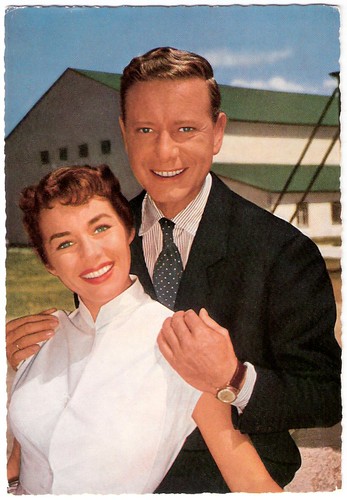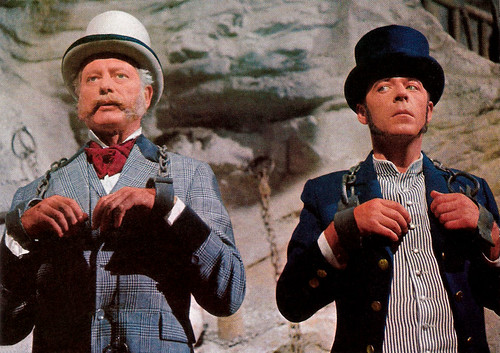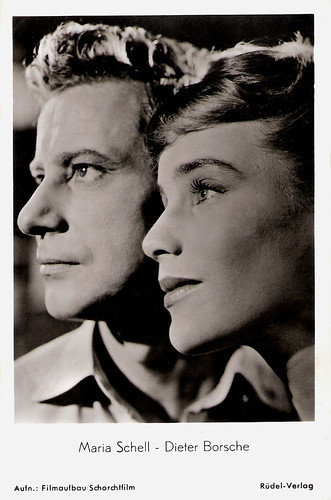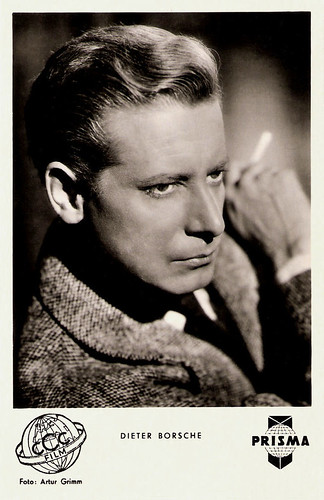
With Marianne Koch. German postcard by WS-Druck, Wanne-Eickel, no. F 79. Photo: Ringpress / Vogelmann / Bavaria.

German postcard by Heinerle Karl-May-Postkarten, no. 43. Photo: CCC / Gloria. Publicity still for Der Schut/The Shoot (Robert Siodmak, 1964). Caption: "'Well, Archibald, was nun?' fragt Sir Lindsay seinen Butler, als sie der Schut unversehends in einer Felsenhöhle, die sich unter seinem Palast befindet, gefangensetzt." ('Archibald now what?', Sir Lindsay (Dieter Borsche) asks his butler (Chris Howland), when The Shoot enexpectedly captures them in a cave, which is located beneath his palace.")
Love affairs
Dieter Albert Eugen Rollomann Borsche was born in Hannover, Germany, in 1909. He was the son of music teacher and director of music Willi Felix Borsche and his wife, oratorio singer Anna Friederike Berta, née Bornmüller.
After attending the gymnasium, Dieter studied dance with Yvonne Georgi and the legendary Harald Kreutzberg. He started his career in 1930 as a ballet dancer at the Städtische Oper in Hannover.
Five years later, after successful acting instruction, he went to work as a jeune premier in the theatre of Weimar. He entered the film business, with a role in Alles weg'n dem Hund/All for the Dog's Sake (Fred Sauer, 1935), a comedy with Weiss-Ferdl.
One of his next films, Preußische Liebesgeschichte/A Prussian Love Story (Paul Martin, 1938) was forbidden because of costar Lída Baroová's affair with Propaganda Minister Joseph Goebbels.
In 1950 the film could finally have its premiere as Liebesgeschichte/Love Story. Borsche took also part in such productions as Die Geliebte/The Loved One (Gerhard Lamprecht, 1939) with Willy Fritsch, but the great breakthrough was refused for the time being.

German postcard by Kunst und Bild, no. A 992. Photo: Filmaufbau / Schorcht Film.

German card. Photo: NDF, Schorchtfilm. Publicity still for Herz der Welt/Heart of the World (Harald Braun, 1952).
Honest, incorruptible characters
After the war, Dieter Borsche worked again in the theatre and in the following decades he became respected as a very intelligent stage actor. Soon he also became one of the most popular German post-war film stars.
His breakthrough was the role of a chaplain in the melodrama Nachtwache/Keepers of the Night (Harald Braun, 1948). He proved to be the ideal actor for such honest, incorruptible characters as an officer in Es kommt ein Tag/A Day Will Come (Rudolf Jugert, 1950), a doctor in Dr. Holl/Affairs of Dr. Holl (Rolf Hansen, 1951) and a prince in Königliche Hoheit/His Royal Highness (Harald Braun, 1953).
He only played out of character as an out-of-work musician who cross-dresses to get a job in a female orchestra in Fanfaren der Liebe/Fanfares of Love (Kurt Hoffmann, 1951), the precursor of Some Like It Hot (Billy Wilder, 1959).
He was the charming partner of Ruth Leuwerik, Nadja Tiller and Marika Rökk in such box office hits as Vater braucht eine Frau/Father Needs a Woman (Harald Braun, 1952), Die Barrings/The Barrings (Rolf Thiele, 1955), Königin Luise/Queen Luise (Wolfgang Liebeneiner, 1957) and Nachts im grünen Kakadu/At Green Cockatoo by Night (Georg Jacoby, 1957).
He also played in international productions including Ali Baba et les quarante voleurs/Ali Baba and the Forty Thieves (Jacques Becker, 1954) with Fernandel and the war drama A Time to Love and a Time to Die (Douglas Sirk, 1958), based on the novel by Erich Maria Remarque.

German postcard by Kunst und Bild, Berlin, no. V 322. Photo: Artur Grimm / Cine-Allianz / Meteor / Constantin.

German postcard by F.J. Rüdel, Filmpostkartenverlag, Hamburg-Bergedorf, no. 560. Photo: Filmaufbau Schorchfilm. Publicity still for Es komt ein Tag/A Day Will Come (1950, Rudolf Jugert).
Muscle atrophy
The 1960s marked the busiest decade in the career of Dieter Borsche. He appeared as a villain in popular crime films of the Edgar Wallace series including Die toten Augen von London/Dead Eyes of London (Alfred Vohrer, 1961), Der Schwarze Abt/The Black Abbot (Franz Josef Gottlieb, 1963) and Der Henker von London/The Mad Executioners (Edwin Zbonek, 1963).
He confirmed his acting abilities on stage with Erwin Piscator, on TV and in films like the thriller Der Rote Rausch/The Red Frenzy (Wolfgang Schleif, 1962), Der Schut/The Shoot (Robert Siodmak, 1964) based on an adventure novel by Karl May, and Der Pfarrer von St. Pauli/The Priest of St. Pauli (Rolf Olsen, 1970) with Curd Jürgens.
Borsche suffered from muscle atrophy for many years and he had to cut down his activities. From the 1970s on he did mainly television and radio plays, and he played stage parts in a wheelchair.
In 1974 he was awarded the Filmband in Gold for his work in the film industry and in 1979 he received the Bundesverdienstkreuz (Germany's Cross of Merit). Dieter Borsche died in 1982 in Nuremberg, Germany.
He had been married three times. With his first wife, set designer Ursula Poser, he was married for 23 years and they had three sons: director and cameraman Kai Borsche (1937), Peter Borsche (1940) and Michael Borsche (1944). In 1960 he married the 25 years old Monika Drum, with whom he had a son, Christian. In 1970 he married for the third and final time, actress Ulla Willick.

German postcard by Kunst und Bild, no. A 284. Photo: Artur Grimm / CCC Film / Prisma.
Dieter Borsche and Georg Thomolla in Fanfaren der Liebe/Fanfares of Love (1951). Source: Lady Violet7 (YouTube).
Sources: Thomas Staedeli (Cyranos), Stephanie D'Heil (Steffi-line.de), Wikipedia and IMDb.
This post was last updated on 13 July 2023.
No comments:
Post a Comment